The terms 3dB and -6dB are often used to describe the frequency response of a speaker system. Faced with the confusion of these two parameters, users mistakenly believe that -6dB is more stringent than the +/- 3dB target. This article will explain the significance of the two indicators, because they are often used (or misused) in the professional audio industry today, as an important basis for parameter comparison between speakers.
The "+/- 3 dB" index is mainly used to describe the flatness of the system-it is not used to describe how strong the frequency extension capability of the speaker is in the high or low range. If someone says this: "My speakers are measured by +/- 3 dB, and they can be very flat between 110Hz and 18KHz." This means that between two frequencies, the reference speaker's frequency response center point is above and below The amplitude will not exceed 3dB. "(Figure 1) shows the range of the dark window area superimposed on the frequency response curve of the small speaker. Here the frequency response of 110Hz-18KHz is accurately controlled in the dark window area.
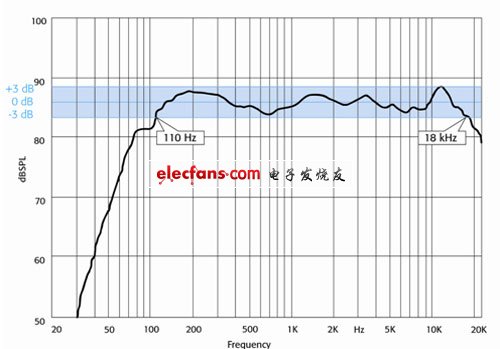
figure 1
Without comparison, the parameter "-6dB" is meaningless. "XxdB SPL, 1 Watt @ 1 meter" is a common reference value for the sensitivity of various speakers. The frequency response curve of the speaker shown in (Figure 2) is the same as (Figure 1). The sensitivity of the speaker is 85dB SPL 1W @ 1 meter, and the frequency response curve expressed by -6dB is the area between two points higher than 79dB, which is 73Hz-20KHz.
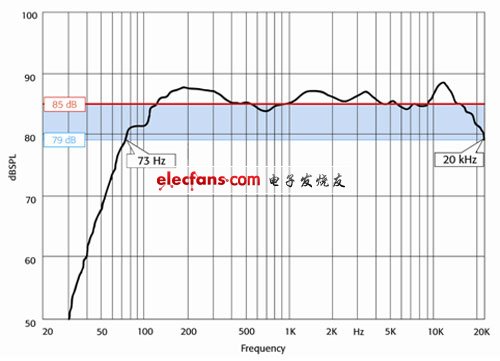
figure 2
If +/- 3dB represents the flat characteristic rather than the frequency response range, then what is the significance of this parameter for the frequency characteristic? Before answering this question, we can take a look at the "+/- 3dB frequency response" marked by the manufacturer on the typical speaker manual.
The written parameters of the speaker are:
Sensitivity (1 Watt @ 1 Meter) 99dB SPL
Frequency response (+/- 3dB) 50Hz-20KHz
Does the manufacturer want to express the flatness of the frequency response? (Figure 3) shows a dark +/- 3dB "flat" area on the frequency response curve. Although this window area wants to cover all the frequency response range, it eventually exceeds the -3dB range due to 59Hz and 2.8KHz There is no doubt that this speaker cannot meet the frequency response requirements of 50Hz-20KHz under the +/- 3dB reference standard.
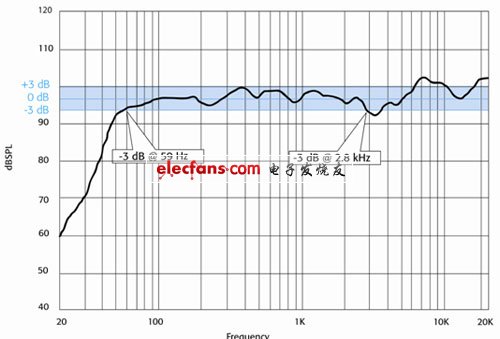
image 3
The speaker manufacturer may measure this +/- 3dB from the 99dB SPL sensitivity. (Figure 4) The center of the dark window area is 99dB, which clearly shows the frequency range of 90Hz-2.5KHz. Although the frequency response curve returns to the dark area at 5KHz, it cannot be said that it is marked by its data. Frequency response of 50Hz-20KHz below +/- 3 dB. Even if the slight drop of 100Hz is ignored, it can only be said that "the frequency response (-3dB) is 90Hz-2.5KHz", while 5KHz-20KHz cannot be expressed with +/- 3 dB.
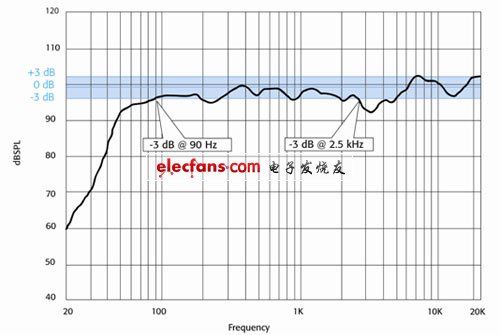
Figure 4
The only option is to move this dark window area to 50Hz (Figure 5). Please keep in mind that decibel is always a relative reference value. If the frequency response of the speaker is 3dB lower at 50Hz, then the question is "What is the relative value reduced by 3dB?" But where does 96dB come from? 96dB is the speaker's 99dB nominal sensitivity minus 3dB. Therefore, the manufacturer's meaning is "At 50Hz, the frequency response is the original -3dB plus a -3dB", you can clearly see that this does not make sense at all, the manufacturer released is actually a -6dB Frequency response data, but expressed in +/- 3dB, the survey found that many other manufacturers have a similar situation.
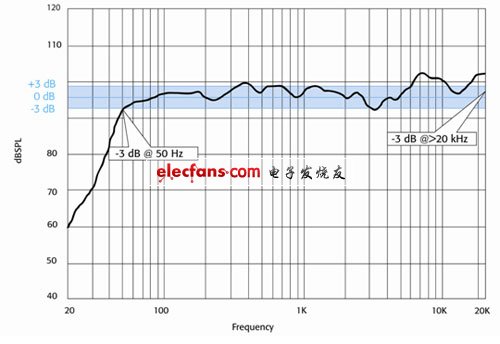
Figure 5
in conclusion
The original intention of the 3dB parameter is to express the flat characteristic of the speaker, and many manufacturers incorrectly use it to indicate the frequency when the sensitivity is 6dB lower than the rated sensitivity. A meaning. QSC generally uses two frequency response parameters of -10dB and -6dB, and also uses -3dB to mark some products. These data are the real parameters of 3dB lower than the sensitivity. During the investigation of this article, we also found that more than one company used the "-3dB frequency response" parameter. Carefully observing their frequency response characteristics is actually at the -6dB parameter, hoping that these errors can be corrected.
The last thing to say is that in any way, the frequency response characteristics cannot be clearly expressed using a pair of data. This parameter is only a rough expression of the rich performance of the speaker.
Introduction
SCOTECH manufactures a full range of three phase distribution transformers, they can be oil immersed or dry type, equipped with or without oil conservator, hermetically sealed or free breathing, with corrugated tank or equipped with radiators. The three phase Distribution Transformer are widely used in power system.
Scope of supply
Primary voltage up to 35KV
Rated power: small size up to 315KVA, medium size up to 2500KVA, large size up to 25MVA
Installation: free standing, pole mounted, pad mounted type
Standards
SCOTECH`s three phase distribution transformers are designed and manufactured in accordance with all major international standards (IEC, ANSI, UL, etc.)
Why SCOTECH
Long history- Focus on transformer manufacturing since 1934.
Technical support – 134 engineers stand by for you 24/7.
Manufacturing-advanced production and testing equipment, strict QA system.
Perfect service-The complete customer service package (from quotation to energization).
Three Phase Distribution Transformer
3 Phase Transformer,Three Phase Transformer,Three Phase Distribution Transformer,Three Phase Pole Mounted Transformer
Jiangshan Scotech Electrical Co.,Ltd , https://www.scotech.com